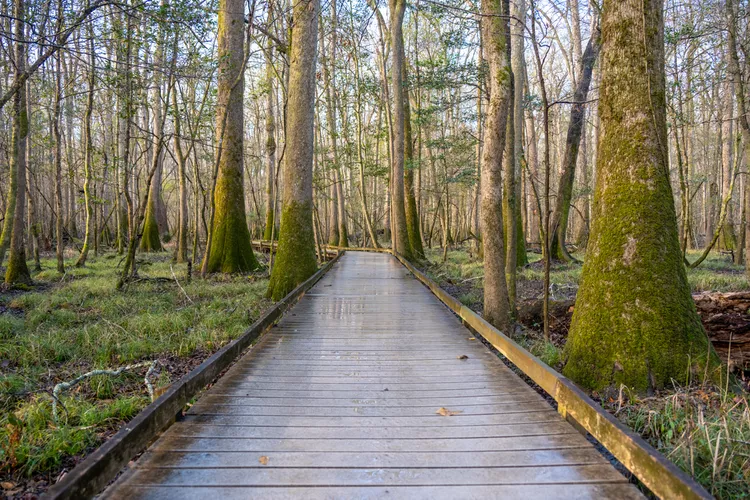Summary
Essential Information Before Visiting Congaree National Park
Biodiversity of Congaree National Park
Congaree National Park in South Carolina is celebrated for its astonishing biodiversity—particularly its vast expanse of old-growth bottomland hardwood forest, recognized as the largest of its kind in North America. The ancient trees, often referred to as “champion trees” due to their remarkable age and size, thrive in the watery floodplain, nourished by the Congaree and Wateree Rivers. These rivers, which flank the park’s eastern and southern borders, feed an intricate network of creeks throughout the park, delivering essential nutrients and sediments crucial for sustaining the ecosystem.
Despite containing over 26,000 acres of relatively untouched wilderness, Congaree National Park is conveniently located just a 30-minute drive from Columbia, South Carolina’s capital. While best known for its majestic old-growth forest and vibrant waterways, the park also offers excellent hiking, enabling visitors to immerse themselves in the Congaree wilderness. Fishing and the rare synchronous fireflies are among the park’s notable attractions.
Things to Do at Congaree National Park
The park’s waterways, vital for enriching the old-growth forest, serve as a playground for visitors. The Cedar Creek Canoe Trail winds beneath some of Eastern North America’s tallest trees on its 15-mile journey through the wilderness. Experienced paddlers often tackle the 50-mile Congaree River Blue Trail, which begins in Columbia and flows downstream through the park.
For those looking for a more relaxed experience, canoes or kayaks can be rented from local outfitters, or guided paddling tours can be arranged through the park.
Congaree boasts a surprising number of trails, many of which feature elevated boardwalks that keep hikers dry. Most trails begin at the Harry Hampton Visitor Center, and since the park is situated in a floodplain, the pathways are mostly flat. Popular routes include the easy Boardwalk Loop Trail and the more challenging Kingsnake Trail, favored by bird enthusiasts.
In spring, the Firefly Trail transforms into a captivating nighttime adventure, guiding visitors into the depths of the forest where a rare species of firefly—the synchronous firefly—provides a mesmerizing light display during their mating season.
Where to Stay
To truly immerse yourself in the wonders of Congaree National Park, consider staying overnight. Although there are no lodges, two campgrounds feature basic overnight amenities and offer stunning night skies filled with stars (and perhaps even a firefly or two).
The Longleaf Campground is conveniently located next to the park entrance road, serving as a seamless base for overnight visitors. This walk-up campground requires campers to park nearby and carry their gear to one of the 10 individual or four group sites. While there is no water available, it can be accessed 24/7 at the Harry Hampton Visitor Center.
Campers at Bluff Campground must either bring their own water or refill at the visitor center before transporting their equipment to the campground’s six individual sites. Reservations are mandatory for all campsites and can be made through Recreation.gov.
For those seeking adventure in Congaree’s vast wilderness, backcountry camping is an option, which requires a hike or boat ride to access. While permits for backcountry camping are free, they must be requested at least 72 hours in advance via email (sent to cong_information@nps.gov).
How to Get There
Despite its wild setting, Congaree National Park is notably easy to reach. The Harry Hampton Visitor Center is located just over 30 minutes by car from downtown Columbia, less than two hours from Charleston, South Carolina, and an hour and a half from Augusta, Georgia. This visitor center serves as the primary hub for most of the park’s activities and represents an excellent starting point for exploration.
When to Visit Congaree National Park
The park is open year-round, and due to South Carolina’s mild winters, many of the trails and waterways remain accessible during the coldest months. However, spring and fall offer the best visiting conditions, featuring pleasant temperatures and fewer insects.
Spring (March to May) is an exceptional time to experience the park, particularly if your visit coincides with the annual synchronous firefly mating season (provided you can secure a pass). This event, occurring over two weeks between mid-May and June, showcases thousands of fireflies that illuminate the area in unison, creating a magical spectacle. The popularity of this event has led to the introduction of a lottery system for obtaining viewing passes.
In the fall (September to November), temperatures gradually decrease and the foliage transforms into stunning fall colors. The peak foliage typically occurs from late October to early November, making it a prime time for paddling along Cedar Creek.





